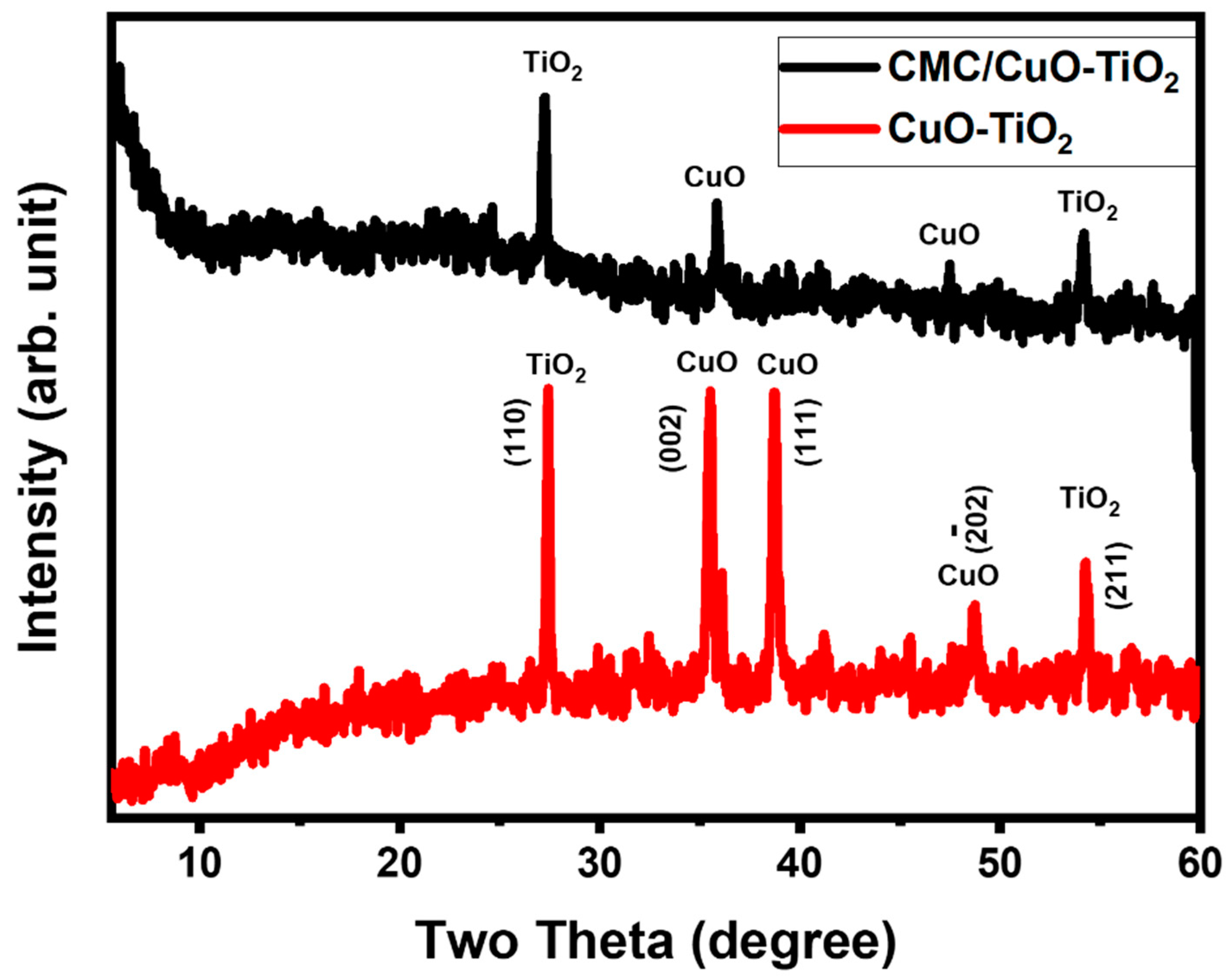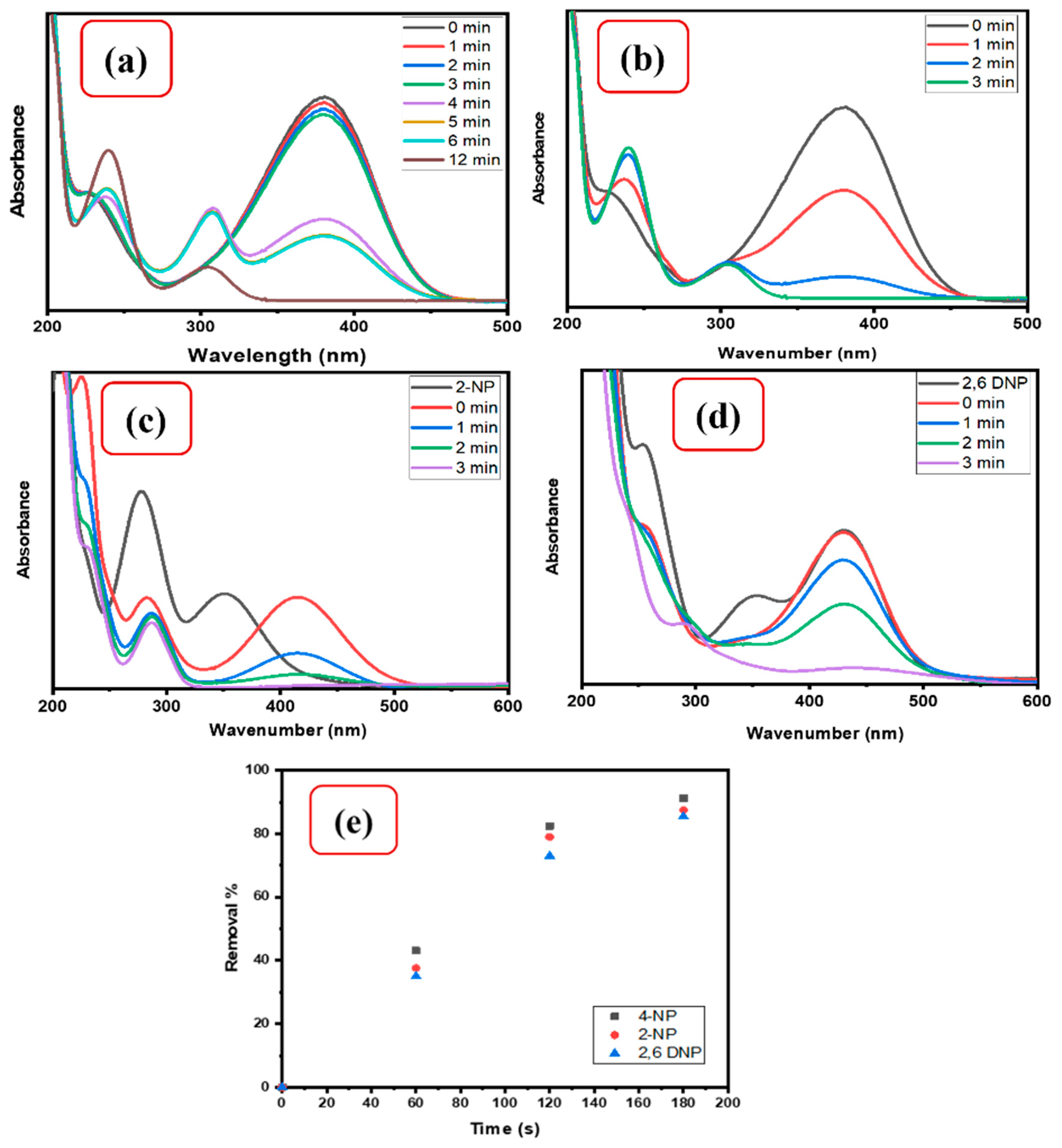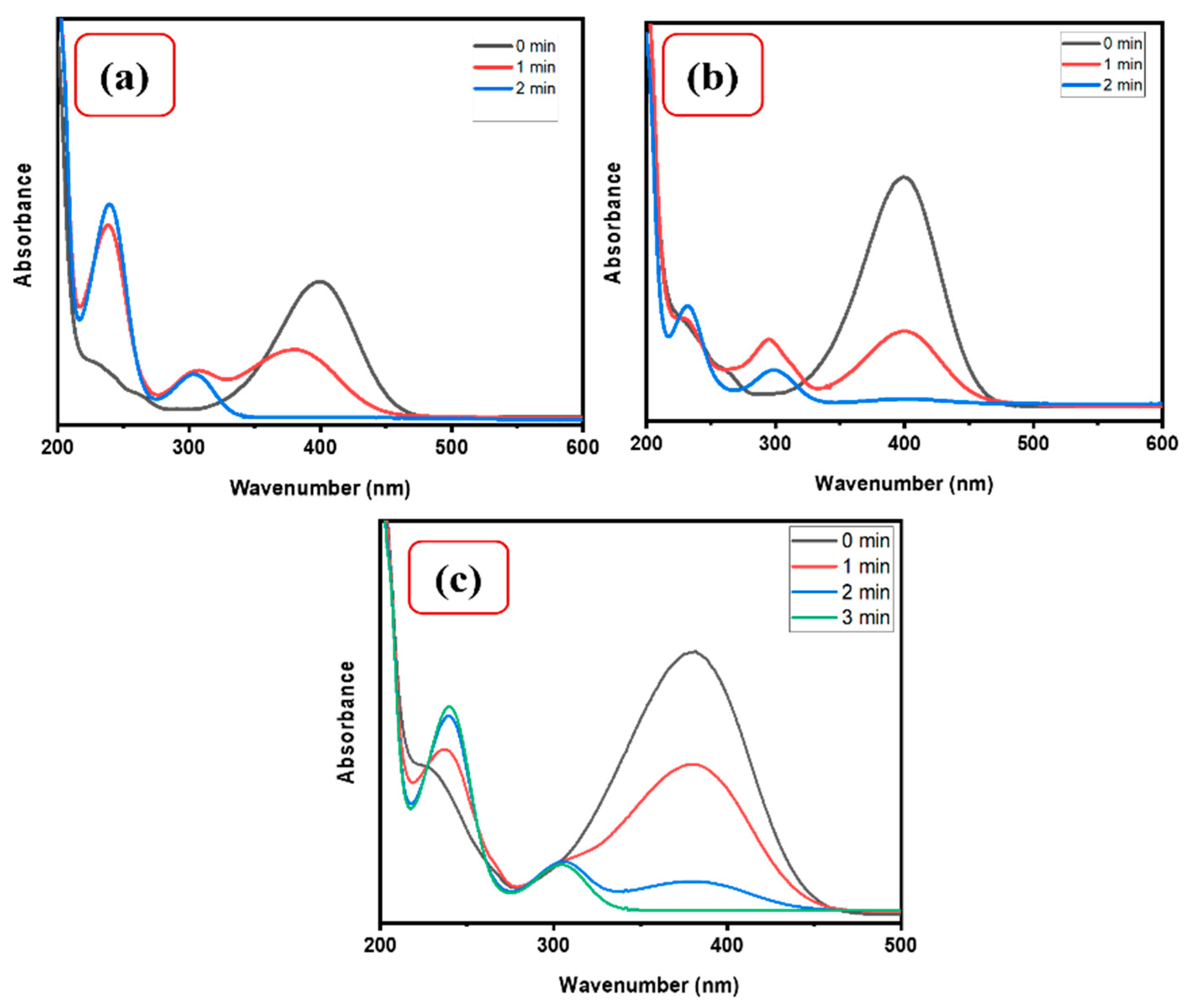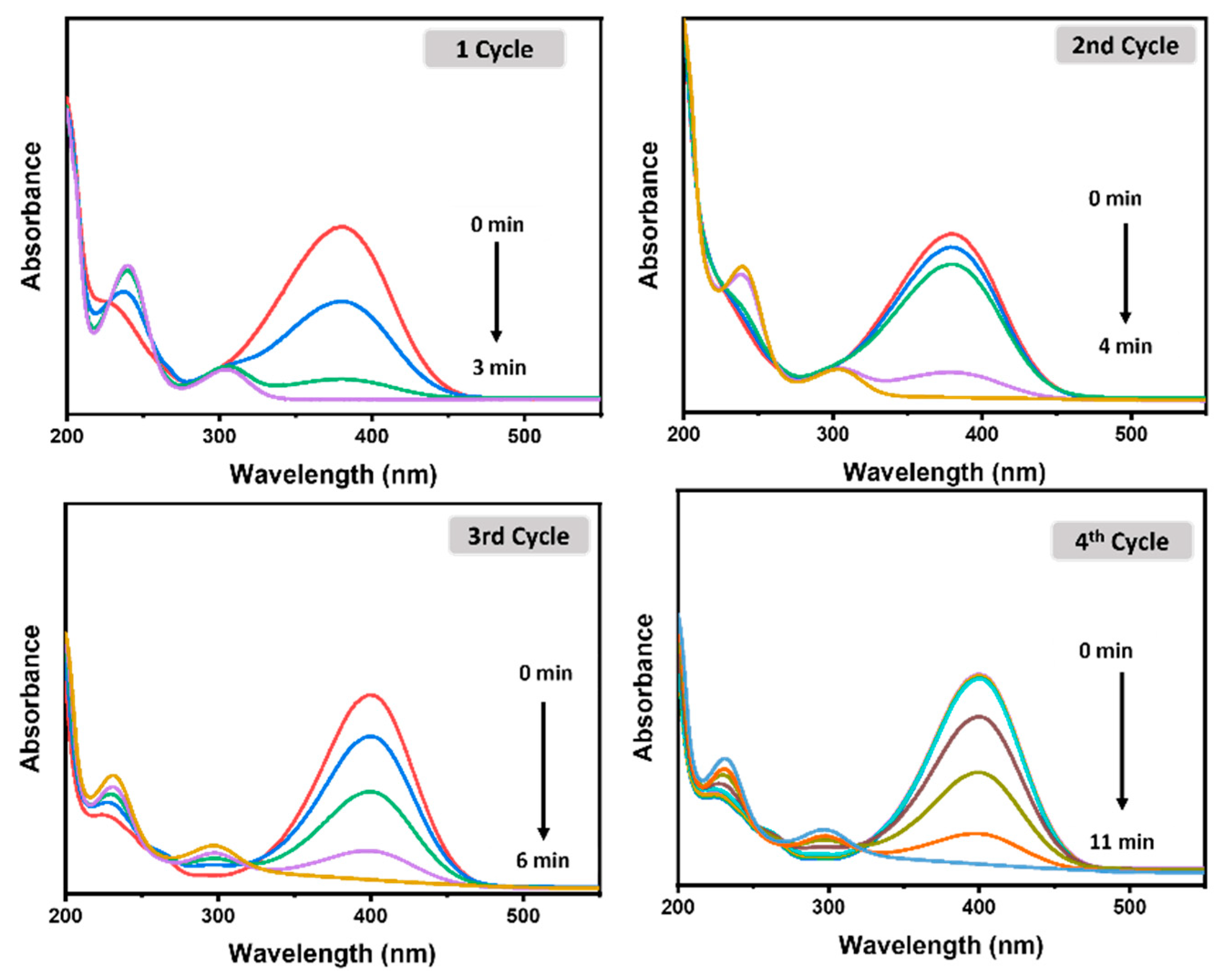Carboxymethyl Cellulose/Copper Oxide–Titanium Oxide Based Nanocatalyst Beads for the Reduction of Organic and Inorganic Pollutants
Abstract
:1. Introduction
2. Experimental
2.1. Chemicals and Reagents
2.2. Synthesis of CuO-TiO2 Nanoparticles
2.3. Preparation of CMC/CuO-TiO2 Nanocatalyst Beads
2.4. Characterization
2.5. Catalytic Reduction
3. Result and Discussion
3.1. Characterization
3.1.1. Scanning Electron Microscope (SEM)
3.1.2. X-ray Diffraction (XRD)
3.1.3. EDS Analysis
3.2. Catalytic Reduction
3.2.1. Reduction of Nitrophenol Isomers
Effect of 4-Nitrophenol Concentration
Effect of NaBH4 Concentration
3.2.2. Reduction of Organic Dyes
3.2.3. Reduction of Inorganic Complex
3.2.4. Catalyst Stability and Reusability
3.2.5. Catalytic Efficiency of CMC/CuO-TiO2 Beads in Real Samples
4. Conclusions
Author Contributions
Funding
Institutional Review Board Statement
Informed Consent Statement
Data Availability Statement
Acknowledgments
Conflicts of Interest
References
- Maslamani, N.; Khan, S.B.; Danish, E.Y.; Bakhsh, E.M.; Zakeeruddin, S.M.; Asiri, A.M. Carboxymethyl cellulose nanocomposite beads as super-efficient catalyst for the reduction of organic and inorganic pollutants. Int. J. Biol. Macromol. 2021, 167, 101–116. [Google Scholar] [CrossRef] [PubMed]
- Sohni, S.; Norulaini, N.N.; Hashim, R.; Khan, S.B.; Fadhullah, W.; Omar, A.M. Physicochemical characterization of Malaysian crop and agro-industrial biomass residues as renewable energy resources. Ind. Crop. Prod. 2018, 111, 642–650. [Google Scholar] [CrossRef]
- Ismail, M.; Gul, S.; Khan, M.; Asiri, A.M.; Khan, S.B. Green synthesis of zerovalent copper nanoparticles for efficient reduction of toxic azo dyes congo red and methyl orange. Green Process. Synth. 2019, 8, 135–143. [Google Scholar] [CrossRef]
- Khan, S.A.; Khan, S.B.; Asiri, A.M. Layered double hydroxide of Cd-Al/C for the mineralization and de-coloration of dyes in solar and visible light exposure. Sci. Rep. 2016, 6, 35107. [Google Scholar] [CrossRef] [PubMed] [Green Version]
- Jang, E.S.; Khan, S.B.; Seo, J.; Akhtar, K.; Choi, J.; Kim, K.I.; Han, H. Synthesis and characterization of novel UV-curable PU-Si hybrids: Influence of silica on thermal, mechanical, and water sorption properties of polyurethane acrylates. Macromol. Res. 2011, 19, 1006–1013. [Google Scholar] [CrossRef]
- Khan, S.B.; Bakhsh, E.M.; Akhtar, K.; Kamal, T.; Shen, Y.; Asiri, A.M. Copper oxide-antimony oxide entrapped alginate hydrogel as efficient catalyst for selective reduction of 2-nitrophenol. Polymers 2022, 14, 458. [Google Scholar] [CrossRef]
- Maslamani, N.; Manandhar, E.; Geremia, D.K.; Logue, B.A. ICE concentration linked with extractive stirrer (ICECLES). Anal. Chim. Acta 2016, 941, 41–48. [Google Scholar] [CrossRef] [PubMed] [Green Version]
- Kim, D.; Jung, J.; Kim, Y.; Lee, M.; Seo, J.; Khan, S.B. Structure and thermal properties of octadecane/expanded graphite composites as shape-stabilized phase change materials. Int. J. Heat Mass Transf. 2016, 95, 735–741. [Google Scholar] [CrossRef]
- Zhang, P.; Sui, Y.; Xiao, G.; Wang, Y.; Wang, C.; Liu, B.; Zou, G.; Zou, B. Facile fabrication of faceted copper nanocrystals with high catalytic activity for p-nitrophenol reduction. J. Mater. Chem. A 2013, 1, 1632–1638. [Google Scholar] [CrossRef]
- Farooqi, Z.H.; Sakhawat, T.; Khan, S.R.; Kanwal, F.; Usman, M.; Begum, R. Synthesis, characterization and fabrication of copper nanoparticles in N-isopropylacrylamide based co-polymer microgels for degradation of p-nitrophenol. Mater. Sci. 2015, 33, 185–192. [Google Scholar] [CrossRef] [Green Version]
- Benhadria, N.; Hachemaoui, M.; Zaoui, F.; Mokhtar, A.; Boukreris, S.; Attar, T.; Belarbi, L.; Boukoussa, B. Catalytic reduction of methylene blue dye by copper oxide nanoparticles. J. Clust. Sci. 2022, 33, 249–260. [Google Scholar] [CrossRef]
- Ren, Z.-H.; Li, H.-T.; Gao, Q.; Wang, H.; Han, B.; Xia, K.-S.; Zhou, C.-G. Au nanoparticles embedded on urchin-like TiO2 nanosphere: An efficient catalyst for dyes degradation and 4-nitrophenol reduction. Mater. Des. 2017, 121, 167–175. [Google Scholar] [CrossRef]
- Guo, X.; Chen, F. Removal of arsenic by bead cellulose loaded with iron oxyhydroxide from groundwater. Environ. Sci. Technol. 2005, 39, 6808–6818. [Google Scholar] [CrossRef]
- Sundaram, M.; Kalpana, S.; Sivaganesan, V.; Nandhakumar, E. Studies on the catalytic activity of CuO/TiO2/ZnO ternary nanocomposites prepared via one step hydrothermal green approach. Mater. Res. Express 2019, 6, 125043. [Google Scholar]
- Li, P.; Zhang, X.; Wang, J.; Xu, B.; Zhang, X.; Fan, G.; Zhou, L.; Liu, X.; Zhang, K.; Jiang, W. Binary CuO/TiO2 nanocomposites as high-performance catalysts for tandem hydrogenation of nitroaromatics. Colloids Surfaces A Physicochem. Eng. Asp. 2021, 629, 127383. [Google Scholar] [CrossRef]
- Bakre, P.V.; Kamat, D.P.; Mandrekar, K.S.; Tilve, S.G.; Ghosh, N.N. CuO-NiO-TiO2 bimetallic nanocomposites for catalytic applications. Mol. Catal. 2020, 496, 111193. [Google Scholar] [CrossRef]
- Akbari, R. Green synthesis and catalytic activity of copper nanoparticles supported on TiO2 as a highly active and recyclable catalyst for the reduction of nitro-compounds and degradation of organic dyes. J. Mater. Sci. Mater. Electron. 2021, 32, 15801–15813. [Google Scholar] [CrossRef]
- Kianfar, A.H.; Arayesh, M.A. Synthesis, characterization and investigation of photocatalytic and catalytic applications of Fe3O4/TiO2/CuO nanoparticles for degradation of MB and reduction of nitrophenols. J. Environ. Chem. Eng. 2020, 8, 103640. [Google Scholar] [CrossRef]
- Bathla, A.; Rather, R.A.; Poonia, T.; Pal, B. Morphology dependent photocatalytic activity of CuO/CuO–TiO2 nanocatalyst for degradation of methyl orange under sunlight. J. Nanosci. Nanotechnol. 2020, 20, 3123–3130. [Google Scholar] [CrossRef] [PubMed]
- Gupta, S.; Pathak, A.K.; Ameta, C.; Punjabi, P.B. Microwave-induced expeditious synthesis of biologically active substituted imidazoles using CuO-TiO2-GO nanocomposite as a recyclable catalyst. Lett. Org. Chem. 2021, 18, 318–333. [Google Scholar] [CrossRef]
- Lee, Y.; Kim, D.; Seo, J.; Han, H.; Khan, S.B. Preparation and characterization of poly(propylene carbonate)/exfoliated graphite nanocomposite films with improved thermal stability, mechanical properties and barrier properties. Polym. Int. 2013, 62, 1386–1394. [Google Scholar] [CrossRef]
- Ismail, M.; Khan, M.; Akhtar, K.; Asiri, A.M.; Khan, S.B. Biosynthesis of silver nanoparticles: A colorimetric optical sensor for detection of hexavalent chromium and ammonia in aqueous solution. Phys. E Low Dimens. Syst. Nanostruct. 2018, 103, 367–376. [Google Scholar] [CrossRef]
- Khan, S.B.; Khan, S.A.; Asiri, A.M. A fascinating combination of Co, Ni and Al nanomaterial for oxygen evolution reaction. Appl. Surf. Sci. 2016, 370, 445–451. [Google Scholar] [CrossRef]
- Sikora, E.; Katona, K.K.; Muránszky, G.; Bánhidi, O.; Kristály, F.; Szabó, J.T.; Windisch, M.; Fiser, B.; Vanyorek, L. Cellulose-based catalyst design for efficient chlorate reduction. Arab. J. Chem. 2021, 14, 103202. [Google Scholar] [CrossRef]
- Anwar, Y.; Ali, H.S.M.; Rehman, W.U.; Hemeg, H.A.; Khan, S.A. Antibacterial films of alginate-CoNi-coated cellulose paper stabilized Co NPs for dyes and nitrophenol degradation. Polymers 2021, 13, 4122. [Google Scholar] [CrossRef] [PubMed]
- El Sayed, A.M.; Saber, S. Structural, optical analysis, and Poole–Frenkel emission in NiO/CMC–PVP: Bio-nanocomposites for optoelectronic applications. J. Phys. Chem. Solids 2022, 163, 110590. [Google Scholar] [CrossRef]
- Althomali, R.H.; Alamry, K.A.; Hussein, M.A.; Khan, A.; Alosaimi, A.M. A green nanocomposite based modified cellulose/TiO2/cinnamon bark for the reduction of toxic organic compounds using spectrophotometric technique. J. Mater. Res. Technol. 2021, 12, 947–966. [Google Scholar] [CrossRef]
- Kamal, T.; Ahmad, I.; Khan, S.B.; Asiri, A.M. Bacterial cellulose as support for biopolymer stabilized catalytic cobalt nanoparticles. Int. J. Biol. Macromol. 2019, 135, 1162–1170. [Google Scholar] [CrossRef]
- Khan, M.S.J.; Khan, S.B.; Kamal, T.; Asiri, A.M. Agarose biopolymer coating on polyurethane sponge as host for catalytic silver metal nanoparticles. Polym. Test. 2019, 78, 105983. [Google Scholar] [CrossRef]
- Bakhsh, E.M.; Akhtar, K.; Fagieh, T.M.; Khan, S.B.; Asiri, A.M. Development of alginate@tin oxide–cobalt oxide nanocomposite based catalyst for the treatment of wastewater. Int. J. Biol. Macromol. 2021, 187, 386–398. [Google Scholar] [CrossRef]
- Maslamani, N.; Khan, S.B.; Danish, E.Y.; Bakhsh, E.M.; Akhtar, K.; Asiri, A.M. Metal nanoparticles supported chitosan coated carboxymethyl cellulose beads as a catalyst for the selective removal of 4-nitrophenol. Chemosphere 2022, 291, 133010. [Google Scholar] [CrossRef]
- Jang, E.S.; Khan, S.B.; Seo, J.; Nam, Y.H.; Choi, W.J.; Akhtar, K.; Han, H. Synthesis and characterization of novel UV-curable polyurethane–clay nanohybrid: Influence of organically modified layered silicates on the properties of polyurethane. Prog. Org. Coat. 2011, 71, 36–42. [Google Scholar] [CrossRef]
- Khan, S.B.; Rahman, M.M.; Jang, E.S.; Akhtar, K.; Han, H. Special susceptive aqueous ammonia chemi-sensor: Extended applications of novel UV-curable polyurethane-clay nanohybrid. Talanta 2011, 84, 1005–1010. [Google Scholar] [CrossRef] [PubMed]
- Khan, S.A.; Khan, S.B.; Asiri, A.M. Toward the design of Zn–Al and Zn–Cr LDH wrapped in activated carbon for the solar assisted de-coloration of organic dyes. RSC Adv. 2016, 6, 83196–83208. [Google Scholar] [CrossRef]
- Kamal, T.; Ali, N.; Naseem, A.A.; Khan, S.B.; Asiri, A.M. Polymer nanocomposite membranes for antifouling nanofiltration. Recent Pat. Nanotechnol. 2016, 10, 189–201. [Google Scholar] [CrossRef] [PubMed]
- Tahseen, K.; Ikram, A.; Khan, S.B.; Asiri, A.M. Agar hydrogel supported metal nanoparticles catalyst for pollutants degradation in water. Desalin. Water Treat. 2018, 136, 290–298. [Google Scholar]
- Rokhmat, M.; Wibowo, E.; Abdullah, M. Performance improvement of TiO2/CuO solar cell by growing copper particle using fix current electroplating method. Procedia Eng. 2017, 170, 72–77. [Google Scholar] [CrossRef]
- Liu, L.; Gu, X.; Sun, C.; Li, H.; Deng, Y.; Gao, F.; Dong, L. In situ loading of ultra-small Cu2O particles on TiO2 nanosheets to enhance the visible-light photoactivity. Nanoscale 2012, 4, 6351–6359. [Google Scholar] [CrossRef] [PubMed]
- Abdel-Galil, A.; Ali, H.; Atta, A.; Balboul, M. Influence of nanostructured TiO2 additives on some physical characteristics of carboxymethyl cellulose (CMC). J. Radiat. Res. Appl. Sci. 2014, 7, 36–43. [Google Scholar] [CrossRef] [Green Version]
- Ali, H.; Atta, A.; Senna, M. Physico-chemical properties of carboxymethyl cellulose (CMC)/nanosized titanium oxide (TiO2) gamma irradiated composite. Arab. J. Nucl. Sci. Appl. 2015, 48, 44–52. [Google Scholar]
- Shoukat, A.; Wahid, F.; Khan, T.; Siddique, M.; Nasreen, S.; Yang, G.; Ullah, M.W.; Khan, R. Titanium oxide-bacterial cellulose bioadsorbent for the removal of lead ions from aqueous solution. Int. J. Biol. Macromol. 2019, 129, 965–971. [Google Scholar] [CrossRef]
- Maslamani, N.; Bakhsh, E.M.; Khan, S.B.; Danish, E.Y.; Akhtar, K.; Fagieh, T.M.; Su, X.; Asiri, A.M. Chitosan@carboxymethylcellulose/CuO-CO2O3 nanoadsorbent as a super catalyst for the removal of water pollutants. Gels 2022, 8, 91. [Google Scholar] [CrossRef]
- Ahmad, I.; Kamal, T.; Khan, S.B.; Asiri, A.M. An efficient and easily retrievable dip catalyst based on silver nanoparticles/chitosan-coated cellulose filter paper. Cellulose 2016, 23, 3577–3588. [Google Scholar] [CrossRef]
- Veerakumar, P.; Salamalai, K.; Thanasekaran, P.; Lin, K.-C. Simple preparation of porous carbon-supported ruthenium: Propitious catalytic activity in the reduction of ferrocyanate(III) and a cationic dye. ACS Omega 2018, 3, 12609–12621. [Google Scholar] [CrossRef] [PubMed] [Green Version]
- Xia, Q.; Fu, S.; Ren, G.; Chai, F.; Jiang, J.; Qu, F. Fabrication of Fe3O4@Au hollow spheres with recyclable and efficient catalytic properties. New J. Chem. 2016, 40, 818–824. [Google Scholar] [CrossRef]
- Seo, Y.S.; Ahn, E.-Y.; Park, J.; Kim, T.Y.; Hong, J.E.; Kim, K.; Park, Y.; Park, Y. Catalytic reduction of 4-nitrophenol with gold nanoparticles synthesized by caffeic acid. Nanoscale Res. Lett. 2017, 12, 7. [Google Scholar] [CrossRef] [PubMed] [Green Version]
- Khan, S.A.; Bakhsh, E.M.; Akhtar, K.; Khan, S.B. A template of cellulose acetate polymer-ZnAl/C layered double hydroxide composite fabricated with Ni NPs: Applications in the hydrogenation of nitrophenols and dyes degradation. Spectrochim. Acta Part A Mol. Biomol. Spectrosc. 2020, 241, 118671. [Google Scholar] [CrossRef] [PubMed]
- Amir, M.; Kurtan, U.; Baykal, A.; Sözeri, H. MnFe2O4@PANI@Ag heterogeneous nanocatalyst for degradation of industrial aqueous organic pollutants. J. Mater. Sci. Technol. 2016, 32, 134–141. [Google Scholar] [CrossRef]










| Pollutant | Catalyst | Time (s) | Reference |
|---|---|---|---|
| 4-NP | CMC/CuO-TiO2 | 180 | This Work |
| 4-NP | Co-Cu/CIN/SCMC/TiO2 | 240 | [27] |
| 4-NP | cf-CA-AuNPs | 900 | [46] |
| 4-NP | Fe3O4/TiO2/CuO | 120 | [18] |
| MO | CMC/CuO-TiO2 | 120 | This Work |
| MO | CA-ZA10@Ni NPs | 1080 | [47] |
| MO | Ni/Cs@CMC/CuO-Co2O3 | 120 | [42] |
| EY | CMC/CuO-TiO2 | 240 | This Work |
| EY | Ni/Cs@CMC/CuO-Co2O3 | 360 | [42] |
| EY | MnFe2O4@PANI@Ag | 420 | [48] |
| K3[Fe(CN)6] | CMC/CuO-TiO2 | 60 | This Work |
| K3[Fe(CN)6] | Ni/Cs@CMC/CuO-Co2O3 | 360 | [42] |
| K3[Fe(CN)6] | Alg@Cu2O-Sb2O3 | 180 | [6] |
| K3[Fe(CN)6] | CMC/CuO-NiO | 40 | [1] |
| Real Sample | Reduction Time (min) | % Reduction |
|---|---|---|
| Orange Juice | 5.0 | 92.6% |
| Full-Fat Milk | 10.0 | 79.4% |
| Wastewater | 5.0 | 89.2 |
| Seawater | 11.0 | 82.5% |
Disclaimer/Publisher’s Note: The statements, opinions and data contained in all publications are solely those of the individual author(s) and contributor(s) and not of MDPI and/or the editor(s). MDPI and/or the editor(s) disclaim responsibility for any injury to people or property resulting from any ideas, methods, instructions or products referred to in the content. |
© 2023 by the authors. Licensee MDPI, Basel, Switzerland. This article is an open access article distributed under the terms and conditions of the Creative Commons Attribution (CC BY) license (https://creativecommons.org/licenses/by/4.0/).
Share and Cite
Bakhsh, E.M.; Khan, S.B.; Maslamani, N.; Danish, E.Y.; Akhtar, K.; Asiri, A.M. Carboxymethyl Cellulose/Copper Oxide–Titanium Oxide Based Nanocatalyst Beads for the Reduction of Organic and Inorganic Pollutants. Polymers 2023, 15, 1502. https://doi.org/10.3390/polym15061502
Bakhsh EM, Khan SB, Maslamani N, Danish EY, Akhtar K, Asiri AM. Carboxymethyl Cellulose/Copper Oxide–Titanium Oxide Based Nanocatalyst Beads for the Reduction of Organic and Inorganic Pollutants. Polymers. 2023; 15(6):1502. https://doi.org/10.3390/polym15061502
Chicago/Turabian StyleBakhsh, Esraa M., Sher Bahadar Khan, Nujud Maslamani, Ekram Y. Danish, Kalsoom Akhtar, and Abdullah M. Asiri. 2023. "Carboxymethyl Cellulose/Copper Oxide–Titanium Oxide Based Nanocatalyst Beads for the Reduction of Organic and Inorganic Pollutants" Polymers 15, no. 6: 1502. https://doi.org/10.3390/polym15061502







